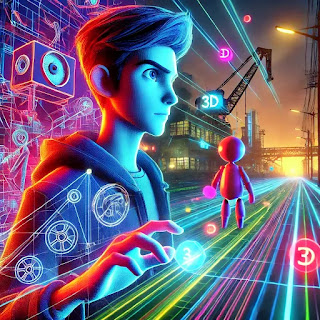Animation is an ever-evolving art form that has seen monumental shifts over the
years. From the hand-drawn classics like Snow White to the groundbreaking visual
spectacle of Toy Story, the animation industry has come a long way. With the rise
of 3D animation, many believed that traditional 2D animation would slowly fade
into obscurity. However, rather than one style overtaking the other, the future of
animation lies in the seamless merging of 2D and 3D techniques. This hybrid
approach is revolutionizing how stories are told, offering new creative possibilities
for animators and studios alike.
The Evolution of Animation Techniques
Historically, 2D animation has been the foundation of the animation industry. Artists
would painstakingly hand-draw every frame, resulting in iconic characters and stories.
Disney's golden age of 2D films, such as The Lion King and Aladdin, demonstrated
the emotional depth and artistic flair possible with traditional methods.
With the advent of 3D animation, the industry underwent a significant shift. Studios
like Pixar and DreamWorks showcased the potential of computer-generated imagery
(CGI), offering lifelike textures, detailed environments, and dynamic camera
movements. The success of films like Toy Story and Shrek cemented the dominance
of 3D animation, with many studios transitioning to this method.
However, while 3D animation services have brought stunning advancements, the
unique charm and artistic expression of 2D animation remain beloved by audiences.
This has led to a new trend in animation—merging 2D animation services with 3D
animation techniques to create visually striking and emotionally resonant content.
The Benefits of Merging 2D and 3D Animation
Enhanced Visual Aesthetics: Combining 2D and 3D animation brings together
the best of both worlds. 2D animation allows for expressive character designs and
artistic stylization, while 3D animation offers depth, texture, and realism. By merging
these techniques, animators can craft unique visual styles that stand out in a
crowded market.
A notable example of this approach is the film Spider-Man: Into the Spider-Verse.
This animated movie seamlessly blends 2D comic book-style effects with 3D character
models and environments. The result is a visually groundbreaking film that feels both
nostalgic and modern, paying homage to 2D comics while leveraging the strengths
of 3D technology.
Innovative Storytelling: By combining 2D and 3D, animators can push the
boundaries of storytelling. For instance, 3D animation services allow for dynamic
camera angles and lifelike environments, while 2D animation services can be used
to emphasize emotional beats, visual metaphors, and artistic flourishes that would
be difficult to achieve with pure CGI.
This approach offers more flexibility in how stories are told, allowing animators to
switch between styles for different narrative purposes. A scene might feature a
richly detailed 3D world, while a character’s inner thoughts and emotions are
illustrated through stylized 2D effects, creating a deeper connection between the
audience and the story.
Cost Efficiency: Merging 2D and 3D animation can also reduce production costs.
While 3D animation services are typically more resource-intensive due to rendering
requirements, integrating 2D elements can help streamline certain aspects of the
process. For instance, a 3D environment can serve as the background, while 2D
animation is used for simpler or more stylized foreground elements, reducing the
overall rendering time and complexity.
Creative Flexibility: The hybrid approach allows animators more creative freedom.
They can experiment with various styles, blending the crisp, clean lines of 2D
animation with the depth and realism of 3D worlds. This opens up endless
possibilities for unique storytelling methods and visual experiments.
Successful Examples of Merging 2D and 3D Animation
Several notable projects have already demonstrated the power of merging 2D
and 3D animation techniques.
The Amazing World of Gumball: This popular animated series seamlessly merges
2D animation with 3D backgrounds and characters, creating a playful, multi-
dimensional world. The show’s creators use this hybrid approach to great effect,
allowing for creative gags and visual storytelling techniques that wouldn’t be
possible with just one style.
Klaus: Netflix’s Klaus is another excellent example of merging 2D and 3D techniques.
While the film primarily uses 2D animation services, it incorporates 3D lighting
and shading technologies to create a unique visual style that feels both modern
and nostalgic. The film’s success showcases the future potential of blending
these techniques to create innovative, emotionally resonant stories.
Arcane: Based on the League of Legends universe, Arcane is an excellent
example of merging 2D animation techniques with 3D character models and
environments. The series combines hand-drawn 2D effects, such as motion lines
and texture, with detailed 3D environments and characters, creating a visually
stunning and immersive experience.
The Future of 2D and 3D Animation
As technology continues to evolve, the merging of 2D and 3D animation will
become even more seamless. We can expect to see more projects embracing
this hybrid approach, pushing the boundaries of what’s possible in both
animation styles.
For companies offering 3D animation services and 2D animation services,
this presents a unique opportunity to expand their creative portfolios and offer
innovative solutions to clients. Studios that can effectively merge these
techniques will be well-positioned to stand out in a competitive industry.
Final Thoughts
The future of animation is undoubtedly exciting, with the merging of 2D and 3D
techniques offering new creative possibilities. As more studios experiment with
this hybrid approach, audiences will be treated to visually stunning and emotionally
resonant stories that combine the best aspects of both animation styles. Whether
it’s for film, TV, video games, or marketing, the fusion of 2D animation services
and 3D animation services is set to shape the future of the industry, offering
limitless potential for innovation.

.jpg)

.jpg)
No comments:
Post a Comment